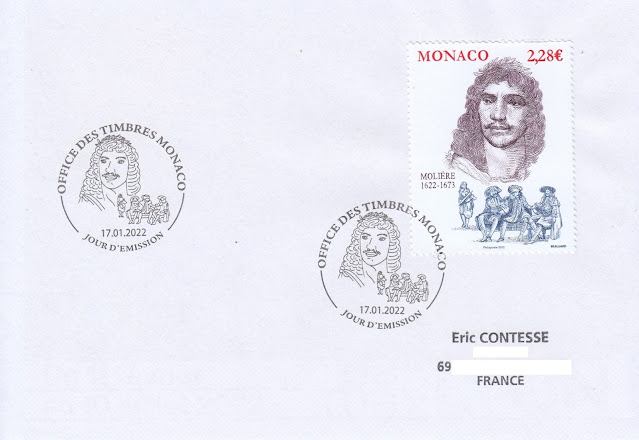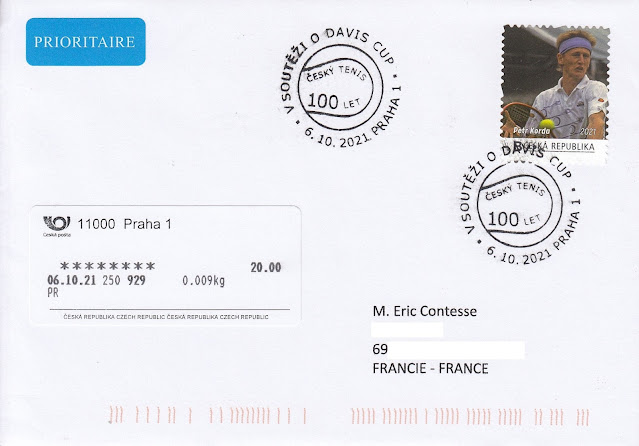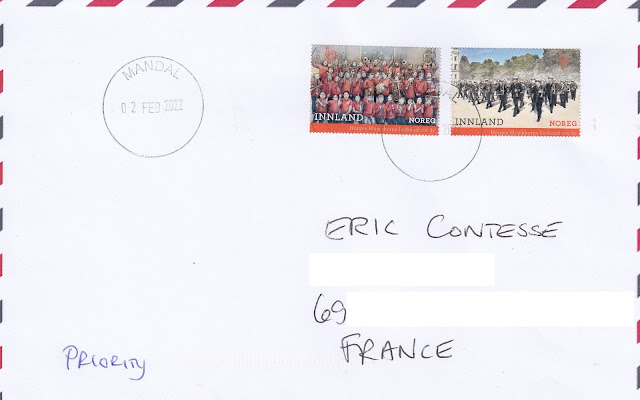Timbres communs avec le Brésil (Tel Aviv et Recife) et l'Ukraine (Shmuel Yosef Agnon), sur lettre d'Israël
Heureux de partager avec vous cette lettre envoyée le 26 janvier 2022 depuis Tel Aviv-Yafo, la capitale économique de l'état d'Israël, affranchie avec 2 de derniers timbres émis conjointement par la poste israélienne, avec le Brésil et l'Ukraine respectivement.
Le timbre à gauche (11,80 shekalim), conçu par Lidia Marina Hurovich Neiva / Ronen Goldberg, a été émis le 8 septembre 2020, une émission commune avec le Brésil, consacrée à des villes côtières des 2 pays, Tel Aviv et Recife.
Le Brésil a joué un rôle important dans la création de l'état d'Israël,
ayant occupé la présidence de l'Assemblée générale des Nations Unies en
1947, qui a proclamé le plan de partage de la Palestine.
Le Brésil a
également été l'un des premiers pays à reconnaître l'état d'Israël, le 7
février 1949, moins d'un an après la déclaration d'indépendance
d'Israël. La première ambassade israélienne a été ouverte en 1955 à Rio
de Janeiro, alors capitale du Brésil.
Happy to share with you this letter sent on January 26, 2022 from Tel Aviv-Yafo, the economic capital of the State of Israel, stamped with two of the latest stamps issued jointly by the Israeli Post, with Brazil and Ukraine respectively.
The stamp on the left (11.80 shekalim), designed by Lidia Marina Hurovich Neiva / Ronen Goldberg, was issued on September 8, 2020, a joint issue with Brazil, dedicated to coastal cities of the 2 countries, Tel Aviv and Recife.
Brazil played an important role in the
creation of the state of Israel, having held the presidency of the
United Nations General Assembly in 1947, which proclaimed the plan for
the partition of Palestine.
Brazil was also one of the first
countries to recognize the state of Israel on February 7, 1949, less
than a year after Israel's declaration of independence. The first
Israeli embassy was opened in 1955 in Rio de Janeiro, then the capital
of Brazil.
Afin de combiner les deux paysages, l'un israélien et l'autre brésilien,
en une seule image sur ce timbre, deux aquarelles ont été créées à
partir de la plage de Tel Aviv, vue depuis Yafo (Jaffa) sur la côte méditerranéenne et de la
plage de Recife vue depuis Olinda, sur la côte atlantique. Pour séparer
et simultanément unir les paysages, un palmier a été représenté.
L'autre timbre (6,50 shekalim), conçu par V. Taran, est une émission commune avec l'Ukraine, émise le 17 août 2021, consacrée à Shmuel Yosef Agnon (1888-1970), le premier écrivain de langue hébraïque à avoir remporté le prix Nobel de littérature en 1966 (partagé avec la poétesse suédoise Nelly Sachs). Il a été désigné pour son art narratif profondément caractéristique avec des motifs de la vie du peuple juif.
Shmuel Yosef Agnon est né à Buczacz, dans l'actuelle Ukraine. Il était l'une des figures centrales de la fiction hébraïque moderne. Ses œuvres traitent du conflit entre la tradition et la langue juives et le monde moderne. Ses premiers ouvrages sont publiés alors qu'il est adolescent et il acquiert immédiatement une notoriété. Son roman révolutionnaire était Hakhnasat kallah (1931).
Après la Seconde Guerre mondiale, sous l'impact de l'holocauste, Agnon écrit Ir Umeloah (1973), une collection de contes populaires, de légendes et de chroniques décrivant sa ville natale, Buczacz.
A noter la présence des drapeaux d'Israël, du Brésil et de l'Ukraine sur les tabs ci-dessus.
In order to combine the two landscapes,
one Israeli and the other Brazilian, into a single image on this stamp,
two watercolors were created from the beach in Tel Aviv, seen from Yafo (Jaffa) on the
Mediterranean coast, and Recife beach seen from Olinda on the Atlantic
coast. To separate and simultaneously unite the landscapes, a palm tree
was featured.
The other stamp (6.50 shekalim), designed by V. Taran, is a joint issue with Ukraine, issued on August 17, 2021, dedicated to Shmuel Yosef Agnon (1888-1970), the first Hebrew language writer having won the Nobel Prize for Literature in 1966 (shared with Swedish poet Nelly Sachs). He was designated for his profoundly characteristic narrative art with motifs from the life of the Jewish people.
Shmuel Yosef Agnon was born in Buczacz, in present-day Ukraine. He was one of the central figures of modern Hebrew fiction. His works deal with the conflict between Jewish tradition and language and the modern world. His first books were published when he was a teenager and he immediately gained notoriety. His breakthrough novel was Hakhnasat kallah (1931).
After World War II, under the impact of the Holocaust, Agnon wrote Ir Umeloah (1973), a collection of folk tales, legends and chronicles describing his hometown, Buczacz.
To note the presence of the flags of Israel, Brazil and Ukraine on the tabs above.

























